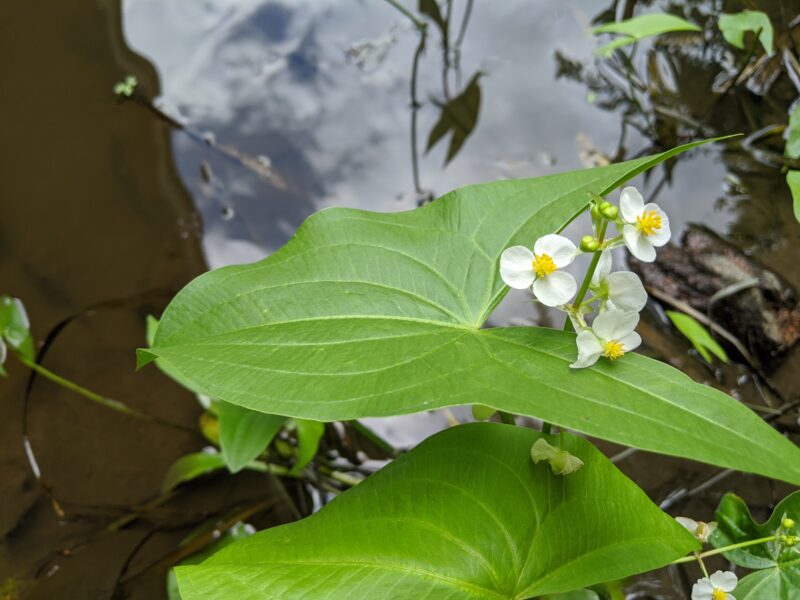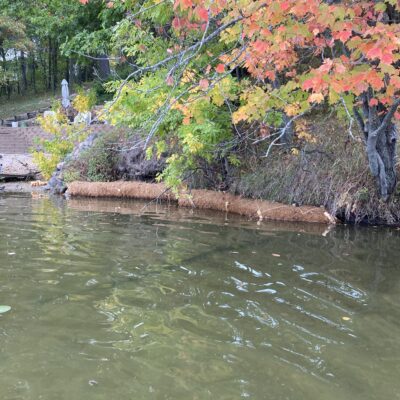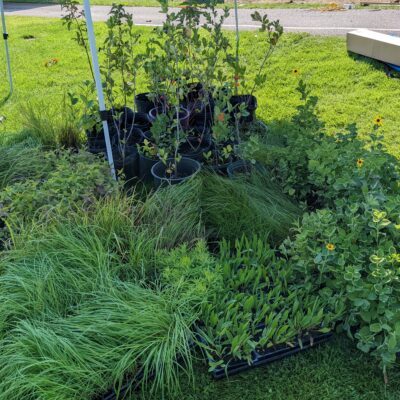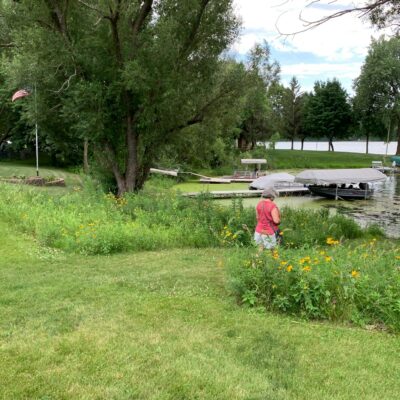
Kat Dickerson is like any other Minnesotan—she loves jumping headfirst into a lake. But during her old job as a water quality monitor, there were some lakes she refused to sample without gloves.
“There was this one lake that had all manicured lawns right to the edge of the lake,” Dickerson recalls. As summer progressed, the lake became as green as the lawns, with a thick layer of algae and dead fish with their fins sticking out of the lake’s surface.
Now, as Natural Resources Specialist with Rock Leaf Water Environmental, Dickerson provides shoreline restoration services to lakeshore property owners throughout the Midwest. Through her projects with Rock Leaf, she is helping more lakes become clearer and attracting more native wildlife.
What we do to our shorelines has a direct impact on the health of our lakes. In Minnesota, lakes play a big part in the thriving of our environment, economy, and ways of life. But over half of Minnesota’s lakes, rivers, and streams are currently designated as impaired.
Changes to our shorelines that cause loss of native plants and more stormwater runoff and erosion lead to excess pollutants entering our waters, creating unsavory conditions like the ones that Dickerson encountered as a water quality monitor. But Minnesotan shoreline owners can work together to reverse this trend—thanks to the power of native plants!

Back to Balance
To support life, a lake must contain essential nutrients like phosphorus and nitrogen. But too much of these nutrients can throw a lake’s ecosystem out of whack. When runoff from rain or melting snow enters a lake, it picks up everything from its journey across our streets and yards, including chemicals, de-icing salt, and excess nutrients from pet waste, dog waste, and fertilizer.
Excess nutrients in a lake triggers uncontrolled algae growth, which can block the sunlight from the aquatic plants that normally provide habitat for fish and hold the lakebed in place with their roots. Without these plants, a shoreline will start to erode, the lake’s edge creeping up higher and higher towards shoreline homes.
One solution to this negative spiral is “lakescaping,” the practice of making healthy landscaping choices along shorelines. Lakescaping emphasizes planting and maintaining dense native vegetation to slow and filter runoff headed towards a lake, which makes a shoreline more resilient to erosion.
Restoring Your Shore with Lakescaping
Dickerson suggests to start by simple observation. “Each shoreline restoration project is going to be different,” Dickerson says, “so start by looking at your own lake.”
Here are some of her suggestions:

- Look at what native plants are already growing, ideally with the same sunlight and water conditions as your shoreline, for ideas on what grows naturally and holds the soil in.
- Consider your own land and your needs, including swimming and dock access. Do construction work first, like removing retaining walls or old docks, so you don’t trample plants. Note that heavy equipment may compact soil, damage plants and make erosion worse.
- Install erosion control. Biodegradable matting, coir logs, cedar revetments, root logs, and brush bundles all help naturally lessen wave action near a lakeshore. By slowing water, they give sediments a chance to settle and seeds of aquatic plants a chance to germinate. Logs or brush bundles also create protection and habitat for fish.
- Bring in the native plants! Including an unmowed “buffer zone” between developed land and the water’s edge mimics a natural shoreline. Consider sunlight and shade amounts, water levels, and soil characteristics when choosing plants. Sprouts are more expensive and will bloom faster, but seeds are easier to put down. Trees or shrubs are also great to add, such as along the edge of your property.
By the time your erosion control naturally breaks down in the water, your native plants will grow a network of roots helping to filter runoff and hold together your shoreline!
Just be careful with newly planted natives. “They may get eaten by animals if you don’t put fences or other types of animal deterrents around them in the beginning,” Dickerson warns. You can also think about adding in a stone walkway or boardwalk along highly trafficked areas. “Excessive foot traffic is a cause of erosion that most people don’t think about,” Dickerson says.
Unexpected Perks

A natural shore comes with benefits beyond protecting water quality. Research has shown a direct connection between property value and water clarity. One 2016 UW-Eau Claire study found that the average home on a murky lake gains $20,000 to $30,000 in property value when water clears enough to see at least a meter down.
Native plant buffers also deter a common lakeshore nuisance: Canada geese. “Geese prefer mowed lawns. They don’t like vegetated shores because they don’t have a quick escape route to the water if they see a predator,” Dickerson says. Native plant buffers keep the geese out and let you keep your lake view with some added privacy, all while bringing in native wildlife like pollinators, dragonflies, frogs, and fish.
Every lakeshore property owner can be a steward of their lake’s health, but a clean lake requires cooperation from us all. To start your shoreline restoration journey, you can begin by attending a Blue Thumb Resilient Shorelines workshop or working with a Blue Thumb partner like Rock Leaf Water Environmental Services. Contact your lake owner association, local watershed management entity, or soil and water conservation district to find out what financial or project assistance may be available to you. For more resources on restoring your shore, selecting plants, and becoming a water steward in your community, check out the links below!
- Explore Rock Leaf Water Environmental’s environmental remediation, restoration, and enhancement services
- Use the Minnesota Department of Natural Resource’s Restore Your Shore Tool for implementing your own project
- Browse best management practices to remediate shore erosion from the Minnesota Department of Natural Resources
- Check the status of your lake with the Minnesota Department of Natural Resources’ Lake Finder
- Don’t own lakeshore property but still want to help? Reduce pollution in runoff by adopting a storm drain near you
– Megan Reich, Metro Blooms Marketing and Communications Specialist
